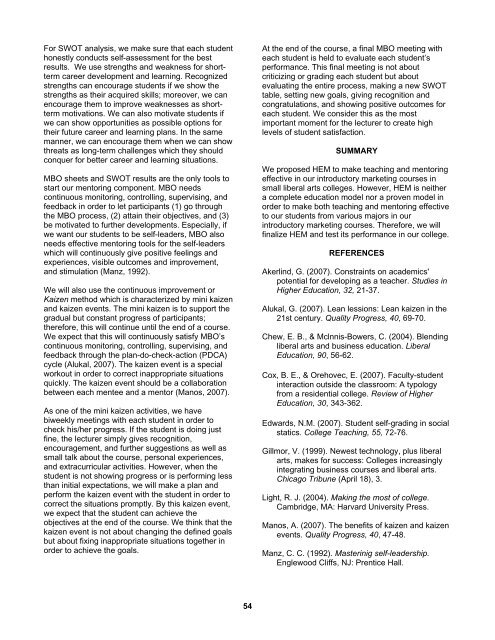2008 - Marketing Educators' Association
2008 - Marketing Educators' Association
2008 - Marketing Educators' Association
Create successful ePaper yourself
Turn your PDF publications into a flip-book with our unique Google optimized e-Paper software.
For SWOT analysis, we make sure that each student<br />
honestly conducts self-assessment for the best<br />
results. We use strengths and weakness for shortterm<br />
career development and learning. Recognized<br />
strengths can encourage students if we show the<br />
strengths as their acquired skills; moreover, we can<br />
encourage them to improve weaknesses as shortterm<br />
motivations. We can also motivate students if<br />
we can show opportunities as possible options for<br />
their future career and learning plans. In the same<br />
manner, we can encourage them when we can show<br />
threats as long-term challenges which they should<br />
conquer for better career and learning situations.<br />
MBO sheets and SWOT results are the only tools to<br />
start our mentoring component. MBO needs<br />
continuous monitoring, controlling, supervising, and<br />
feedback in order to let participants (1) go through<br />
the MBO process, (2) attain their objectives, and (3)<br />
be motivated to further developments. Especially, if<br />
we want our students to be self-leaders, MBO also<br />
needs effective mentoring tools for the self-leaders<br />
which will continuously give positive feelings and<br />
experiences, visible outcomes and improvement,<br />
and stimulation (Manz, 1992).<br />
We will also use the continuous improvement or<br />
Kaizen method which is characterized by mini kaizen<br />
and kaizen events. The mini kaizen is to support the<br />
gradual but constant progress of participants;<br />
therefore, this will continue until the end of a course.<br />
We expect that this will continuously satisfy MBO’s<br />
continuous monitoring, controlling, supervising, and<br />
feedback through the plan-do-check-action (PDCA)<br />
cycle (Alukal, 2007). The kaizen event is a special<br />
workout in order to correct inappropriate situations<br />
quickly. The kaizen event should be a collaboration<br />
between each mentee and a mentor (Manos, 2007).<br />
As one of the mini kaizen activities, we have<br />
biweekly meetings with each student in order to<br />
check his/her progress. If the student is doing just<br />
fine, the lecturer simply gives recognition,<br />
encouragement, and further suggestions as well as<br />
small talk about the course, personal experiences,<br />
and extracurricular activities. However, when the<br />
student is not showing progress or is performing less<br />
than initial expectations, we will make a plan and<br />
perform the kaizen event with the student in order to<br />
correct the situations promptly. By this kaizen event,<br />
we expect that the student can achieve the<br />
objectives at the end of the course. We think that the<br />
kaizen event is not about changing the defined goals<br />
but about fixing inappropriate situations together in<br />
order to achieve the goals.<br />
54<br />
At the end of the course, a final MBO meeting with<br />
each student is held to evaluate each student’s<br />
performance. This final meeting is not about<br />
criticizing or grading each student but about<br />
evaluating the entire process, making a new SWOT<br />
table, setting new goals, giving recognition and<br />
congratulations, and showing positive outcomes for<br />
each student. We consider this as the most<br />
important moment for the lecturer to create high<br />
levels of student satisfaction.<br />
SUMMARY<br />
We proposed HEM to make teaching and mentoring<br />
effective in our introductory marketing courses in<br />
small liberal arts colleges. However, HEM is neither<br />
a complete education model nor a proven model in<br />
order to make both teaching and mentoring effective<br />
to our students from various majors in our<br />
introductory marketing courses. Therefore, we will<br />
finalize HEM and test its performance in our college.<br />
REFERENCES<br />
Akerlind, G. (2007). Constraints on academics'<br />
potential for developing as a teacher. Studies in<br />
Higher Education, 32, 21-37.<br />
Alukal, G. (2007). Lean lessions: Lean kaizen in the<br />
21st century. Quality Progress, 40, 69-70.<br />
Chew, E. B., & Mclnnis-Bowers, C. (2004). Blending<br />
liberal arts and business education. Liberal<br />
Education, 90, 56-62.<br />
Cox, B. E., & Orehovec, E. (2007). Faculty-student<br />
interaction outside the classroom: A typology<br />
from a residential college. Review of Higher<br />
Education, 30, 343-362.<br />
Edwards, N.M. (2007). Student self-grading in social<br />
statics. College Teaching, 55, 72-76.<br />
Gillmor, V. (1999). Newest technology, plus liberal<br />
arts, makes for success: Colleges increasingly<br />
integrating business courses and liberal arts.<br />
Chicago Tribune (April 18), 3.<br />
Light, R. J. (2004). Making the most of college.<br />
Cambridge, MA: Harvard University Press.<br />
Manos, A. (2007). The benefits of kaizen and kaizen<br />
events. Quality Progress, 40, 47-48.<br />
Manz, C. C. (1992). Masterinig self-leadership.<br />
Englewood Cliffs, NJ: Prentice Hall.


